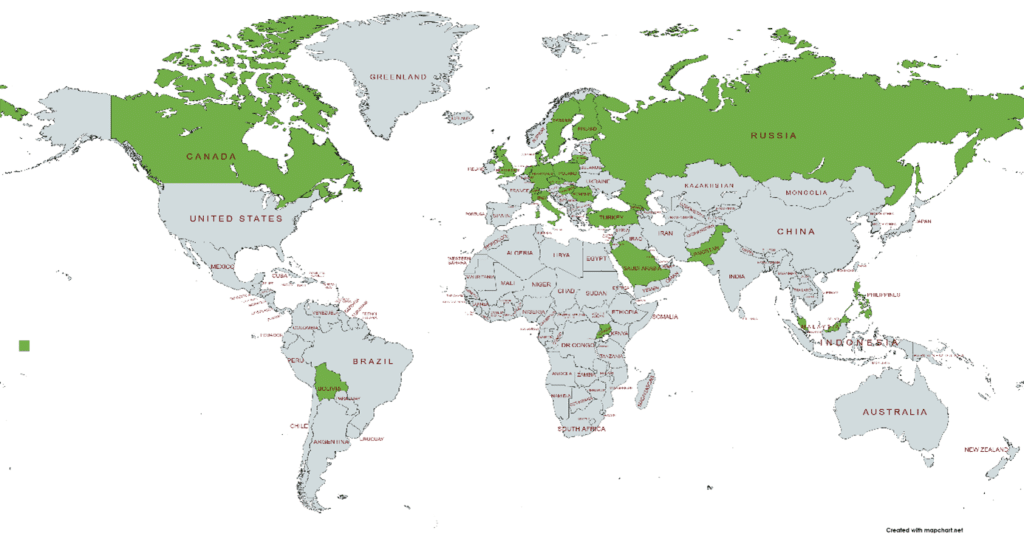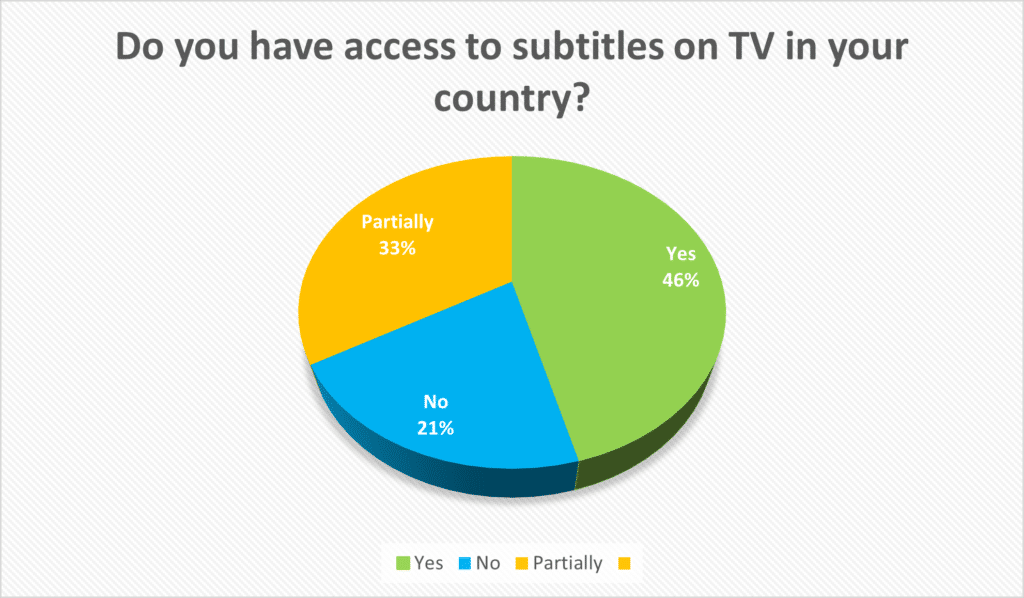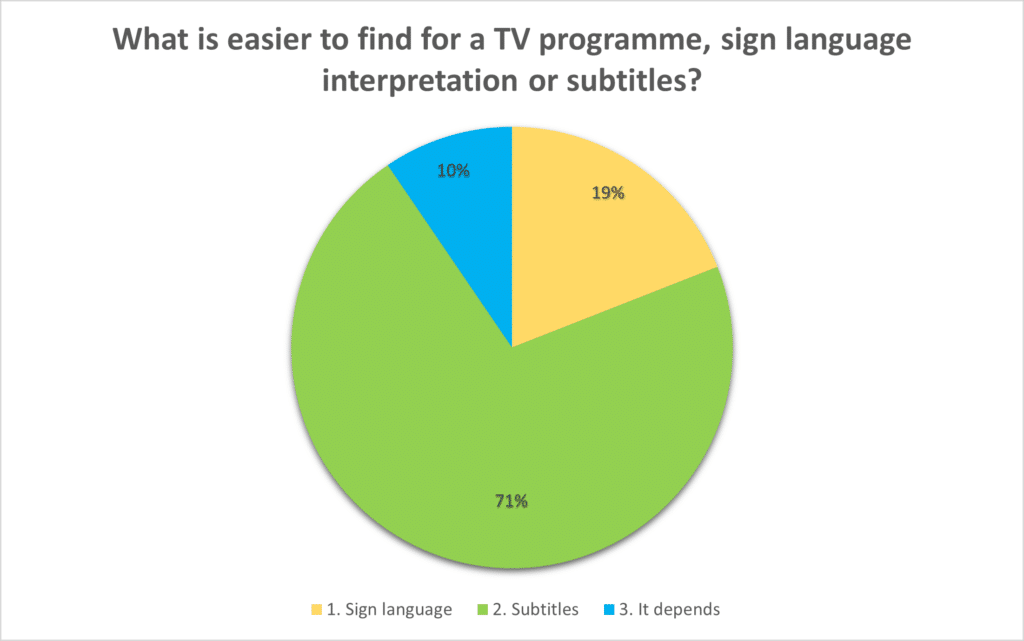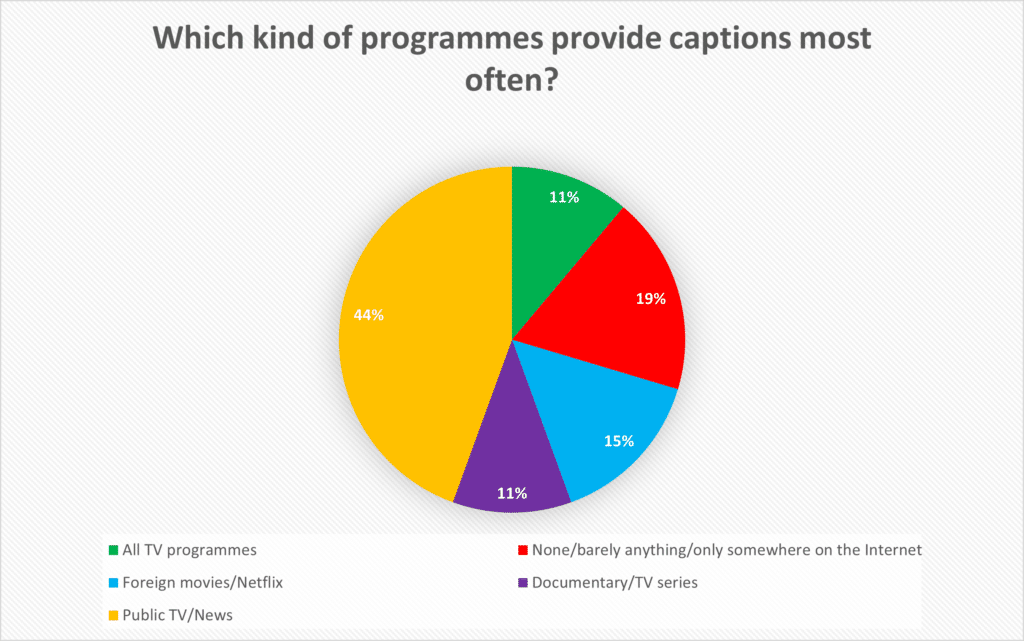Let’s imagine a normal day in your life. You just came back from work, ate dinner, and would like to relax a bit. Or, to know what is going on in your country. Therefore, you switch on TV, select a channel that interests you and just start watching and listening to what is being said…
…watching and listening to what is being said? Wait, wait, wait, it’s not always that simple when you don’t fully understand sounds. But, no worries! There are sign language interpreters or subtitles that you can follow!
…those are there, right?
It is that reflection that led me to this: if actually access to information is provided in each country and to what extent? What I experience is not the same experience shared by another hard of hearing person living somewhere else, most definitely not. Personally, I was kind of shocked when I discovered a captioned TV series at age of 14 for the very first time in my life – before this either someone else told me what was going on in the movie or my dad bought for me some DVDs that contained subtitles. As a hard of hearing person not using too much sign language, sign language interpretation on the news didn’t help much. So, I didn’t watch TV much when I was younger. But, it’s not the case for every country, some of my fellow hard of hearing mates had access to information earlier than me. It is this discovery that left me wondering, how is this in general from country to country?
It’s worth mentioning here that according to this resource and Article 30 of the Convention on the Rights of Persons with Disabilities we have full rights to take part on an equal basis with others in social and cultural life, what means that we should be provided access to materials, programs, films, theatre and other activities in an accessible format. Keep that in your minds!
Therefore we, as the Member and Information Committee, decided to call upon the organizations of hard of hearing young people from all around the world and ask them these three questions:
- Do you have access to subtitles on TV in your country?
- What is easier to find for a TV program, sign language interpretation or subtitles?
- Which kind of programs provide captions most often?
The response was amazing: 21 countries dared to share their insights on this topic. Which countries you ask? Look at this map:

COUNTRIES THAT TOOK PART IN OUR SURVEY (in green):
- Bolivia
- Canada
- Czech Republic
- Denmark
- Finland
- Georgia
- Germany
- Hungary
- Israel
- Lithuania
- Malaysia
- Philippines
- Poland
- Romania
- Russia
- Sweden
- Switzerland
- The Netherlands
- Turkey
- Uganda
- United Kingdom
Honestly, I didn’t expect such great feedback. This survey was in the beginning planned to be a part of another article, but the results overwhelmed me (positively)!
Okay, now let’s have a look at the answers. As I mentioned before, there were many responses. Interestingly enough, sometimes we got more than one response from the same country, and they were different again – showing how it can vary from one region to another. In investigating further, I’ve decided to count each answer, even though they came from the same country.
Okay, enough of the talking, let’s go ahead and see what you shared with us!
Do you have access to subtitles on TV in your country? It seems like a very simple question, yet it appeared to not be so obvious:

Yes: 11
No: 5
The majority of you confirmed that yes, you do have access to subtitles, which is great! Furthermore, some were not so confident answers, confessing that right, there are some captions, but not enough. Hopefully this is an evolving process and will change for the better very soon. And last, but not least, 5 countries said: ‘No, we don’t.’ What can be done to improve this situation? It reminds me even more about urgency of advocating for our rights.
Interesting to note the response from Finland. When asked about the access, we got this answer: ‘Yes, at times, but not in both national languages. News are texted more these days and some shows. All foreign language movies are texted but mostly to Finnish and not on the other national language.’
Finland is the country with two recognized languages: Finnish and Swedish. It means that there appears to be an additional issue why there is noaccess to the citizens of Finland who use Swedish?
There are also many struggles in Bolivia: ‘We don’t have access to subtitles and we rarely know anything about the existence of live subtitling services. […]The worst is that there is a theatre in which we have free access with our disability cards, but we simply cannot choose anything because everything is dubbed in Spanish, so that means removing the subtitles’.
What a paradox, to give to a person with disability free access to an inaccessible event! May just as well tell us , you are not welcome. In another example, Georgia does have occasional access to sign language interpreters, but none to subtitles, which is quite hard for someone like us, who rather use spoken language over signing. But, it doesn’t have to be like that: it can be like in Sweden or Switzerland, where: ‘state television stations usually have subtitles for almost all their own productions (shows, documentaries, news) and films. Even live broadcasts in the evening news have “live” subtitles, which are typed live by editors’
If this is possible in these countries, others can follow this example and hopefully develop increased accessibility over time.
Next question, please!

Ok, ok, It partially appears above, but let’s also check it out anyway!
Sign language: 4
Subtitles: 15
It depends: 2
I found a little paradox here: in general, more people are aware of the existence of a Deaf community than Hard of Hearing people, yet it’s easier to get captions versus a sign language interpreter. 1-0 for subtitles! There is a reason for it. Subtitles are closed subtitles when sign language is open. You cannot simply remove interpreter from your view with a button. If sign language was closed signing, that would probably increase the accessibility of it.
Canada: Subtitles are widely available; whereas ASL is typically only found on news broadcasts.
Czech Republic: Sign language is about 3% only in public TV, more are subtitles.
Germany: We only have two TV News Shows that are interpreted in sign language.
Therefore, it is much easier to find subtitles.
But, there are also cases when it depends, like in Israel, where you can find subtitles for recorded programs and sign language for news. Or Turkey, where:
‘the most news and some local series in the local TV channels have sign language interpretations. Subtitles are somehow harder to find in local TV programs but it is easier to find in TV programs in foreign language rather than in Turkish language.’
Our respondent from Uganda made an important note about this difference, which might partially explain why it’s easier to create subtitles –it is easier to train as subtitler than to become sign language interpreter.
And last (but certainly not least): Which kind of programs provide captions most often?
All TV programs: 3
Barely anything/None/only somewhere on the Internet: 5
Foreign movies/Netflix: 4
Public TV/News/State media: 11
Documentaries/TV series: 2

Our dreamy answer of course: all of them!
And this answer was given by: Malaysia, United Kingdom and Canada, countries which also have strong laws defining accessibility requirements in media. Did you know BBC provided 100% subtitling for all programs and other broadcasters (public and private) are obliged to cover 80%?
However, for the rest of the countries the majority are TV news and foreign movies (it’s good that you can follow major news in your country or learn a foreign language by listening to the original audio and watching captions). Speaking of foreign movies… you should be able to go to the cinema, to watch them with captions. It might cost you more in some places, like in Georgia:
‘movies with subtitles are provided in special rooms, which is special and expensive and they say that every movie here are expensive, not because it has subtitles, because this room has 4 screens. The room makes the price much bigger.’
Romania mentioned something interesting as well:
‘if you go to the cinema, you can request subtitles before the projection. One hour at least as it’s the law.’
Wow!
Other countries are trying to continually improve, like the Czech Republic, where public TV has access to more than 70% of subtitles.
Also, the case of Poland proves possible future improvements: law states that by 2024, subtitles and captions shall apply to universal and specialist programming, containing at least 50% news or current affairs programs, or at least 50% feature films, or at least 50% programs for children, or at least 50% of socio-religious programs. It is said that for the years 2020-2021, captions should appear in 35% of programs in total.
Uff, that’s the end of question 3…
Wow, this topic is so fascinating that we could talk about it all day and night! If you are interested in more details, please check our full list of answers here. Please don’t hesitate to share your experience or brainstorm how can we develop it further, to live to this day, where all hard of hearing people can just come home from work and just relax with any kind of program on TV, enjoying captions or subtitles, whichever you use in your country… 🙂
Credits to: The entire IFHOHYP community that responded to this survey, Lidia Best (Contributor), Maria Skoczyńska (Contributor), and Keegan Noxell (Proofreader)

